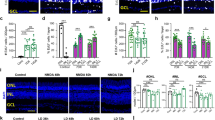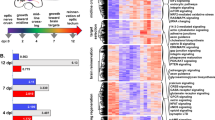Abstract
In zebrafish, retinal injury stimulates Müller glia (MG) reprograming, allowing them to generate multipotent progenitors that replace damaged cells and restore vision. Recent studies suggest that transcriptional repression may underlie these events. To identify transcriptional repressors, we compared the transcriptomes of MG and MG-derived progenitors and identified insm1a, a repressor exhibiting a biphasic pattern of expression that is essential for retina regeneration. Insm1a was found to suppress ascl1a and its own expression, and link injury-dependent ascl1a induction with the suppression of the Wnt inhibitor dickkopf (dkk), which is necessary for MG dedifferentiation. We also found that Insm1a was responsible for sculpting the zone of injury-responsive MG by suppressing h b-e g fa expression. Finally, we provide evidence that Insm1a stimulates progenitor cell-cycle exit by suppressing a genetic program driving progenitor proliferation. Our studies identify Insm1a as a key regulator of retina regeneration and provide a mechanistic understanding of how it contributes to multiple phases of this process.
This is a preview of subscription content, access via your institution
Access options
Subscribe to this journal
Receive 12 print issues and online access
$209.00 per year
only $17.42 per issue
Buy this article
- Purchase on Springer Link
- Instant access to full article PDF
Prices may be subject to local taxes which are calculated during checkout








Similar content being viewed by others
Accession codes
References
Bringmann, A. et al. Cellular signaling and factors involved in Müller cell gliosis: neuroprotective and detrimental effects. Prog. Retin. Eye Res. 28, 423–451 (2009).
Sherpa, T. et al. Ganglion cell regeneration following whole-retina destruction in zebrafish. Dev. Neurobiol. 68, 166–181 (2008).
Fausett, B. V. & Goldman, D. A role for α1 tubulin-expressing Müller glia in regeneration of the injured zebrafish retina. J. Neurosci. 26, 6303–6313 (2006).
Ramachandran, R., Fausett, B. V. & Goldman, D. Ascl1a regulates Müller glia dedifferentiation and retinal regeneration through a Lin-28-dependent, let-7 microRNA signalling pathway. Nat. Cell Biol. 12, 1101–1107 (2010).
Ramachandran, R., Zhao, X. F. & Goldman, D. Ascl1a–Dkk–{β}-catenin signaling pathway is necessary and glycogen synthase kinase-3{β} inhibition is sufficient for zebrafish retina regeneration. Proc. Natl Acad. Sci. USA 108, 15858–15863 (2011).
Thummel, R. et al. Pax6a and Pax6b are required at different points in neuronal progenitor cell proliferation during zebrafish photoreceptor regeneration. Exp. Eye Res. 90, 572–582 (2010).
Thummel, R., Kassen, S. C., Montgomery, J. E., Enright, J. M. & Hyde, D. R. Inhibition of Müller glial cell division blocks regeneration of the light-damaged zebrafish retina. Dev. Neurobiol. 68, 392–408 (2008).
Ramachandran, R., Reifler, A., Parent, J. M & Goldman, D. Conditional gene expression and lineage tracing of tuba1a expressing cells during zebrafish development and retina regeneration. J. Comp. Neurol. 518, 4196–4212 (2010).
Fimbel, S. M., Montgomery, J. E., Burket, C. T. & Hyde, D. R. Regeneration of inner retinal neurons after intravitreal injection of ouabain in zebrafish. J. Neurosci. 27, 1712–1724 (2007).
Karl, M. O. et al. Stimulation of neural regeneration in the mouse retina. Proc. Natl Acad. Sci. USA 105, 19508–19513 (2008).
Osakada, F. et al. Wnt signaling promotes regeneration in the retina of adult mammals. J. Neurosci. 27, 4210–4219 (2007).
Takeda, M. et al. α-aminoadipate induces progenitor cell properties of Müller glia in adult mice. Invest. Ophthalmol. Vis. Sci. 49, 1142–1150 (2008).
Wan, J. et al. Preferential regeneration of photoreceptor from Müller glia after retinal degeneration in adult rat. Vision Res. 48, 223–234 (2008).
Qin, Z., Barthel, L. K. & Raymond, P. A. Genetic evidence for shared mechanisms of epimorphic regeneration in zebrafish. Proc. Natl Acad. Sci. USA 106, 9310–9315 (2009).
Kassen, S. C. et al. CNTF induces photoreceptor neuroprotection and Müller glial cell proliferation through two different signaling pathways in the adult zebrafish retina. Exp. Eye Res. 88, 1051–1064 (2009).
Wan, J., Ramachandran, R. & Goldman, D. HB-EGF is necessary and sufficient for Müller glia dedifferentiation and retina regeneration. Dev. Cell 22, 334–347 (2012).
Craig, S. E. et al. The zebrafish galectin Drgal1-l2 is expressed by proliferating Müller glia and photoreceptor progenitors and regulates the regeneration of rod photoreceptors. Invest. Ophthalmol. Vis. Sci. 51, 3244–3252 (2010).
Hochmann, S. et al. Fgf signaling is required for photoreceptor maintenance in the adult zebrafish retina. PLoS One 7, e30365 (2012).
Kassen, S. C. et al. Time course analysis of gene expression during light-induced photoreceptor cell death and regeneration in albino zebrafish. Dev. Neurobiol. 67, 1009–1031 (2007).
Dyer, M. A. & Cepko, C. L. p27Kip1 and p57Kip2 regulate proliferation in distinct retinal progenitor cell populations. J. Neurosci. 21, 4259–4271 (2001).
Shkumatava, A. & Neumann, C. J. Shh directs cell-cycle exit by activating p57Kip2 in the zebrafish retina. EMBO Rep. 6, 563–569 (2005).
Topark-Ngarm, A. et al. CTIP2 associates with the NuRD complex on the promoter of p57KIP2, a newly identified CTIP2 target gene. J. Biol. Chem. 281, 32272–32283 (2006).
Lan, M. S., Russell, E. K., Lu, J., Johnson, B. E. & Notkins, A. L. IA-1, a new marker for neuroendocrine differentiation in human lung cancer cell lines. Cancer Res. 53, 4169–4171 (1993).
Pedersen, N. et al. Transcriptional gene expression profiling of small cell lung cancer cells. Cancer Res. 63, 1943–1953 (2003).
Farkas, L. M. et al. Insulinoma-associated 1 has a panneurogenic role and promotes the generation and expansion of basal progenitors in the developing mouse neocortex. Neuron 60, 40–55 (2008).
Rosenbaum, J. N., Duggan, A. & Garcia-Anoveros, J. Insm1 promotes the transition of olfactory progenitors from apical and proliferative to basal, terminally dividing and neuronogenic. Neural Dev. 6, 6 (2011).
Jacob, J. et al. Insm1 (IA-1) is an essential component of the regulatory network that specifies monoaminergic neuronal phenotypes in the vertebrate hindbrain. Development 136, 2477–2485 (2009).
Wildner, H., Gierl, M. S., Strehle, M., Pla, P. & Birchmeier, C. Insm1 (IA-1) is a crucial component of the transcriptional network that controls differentiation of the sympatho-adrenal lineage. Development 135, 473–481 (2008).
Lukowski, C. M., Ritzel, R. G. & Waskiewicz, A. J. Expression of two insm1-like genes in the developing zebrafish nervous system. Gene expression patterns: GEP 6, 711–718 (2006).
Morris, A. C., Forbes-Osborne, M. A., Pillai, L. S. & Fadool, J. M. Microarray analysis of XOPS-mCFP zebrafish retina identifies genes associated with rod photoreceptor degeneration and regeneration. Invest. Ophthalmol. Vis. Sci. 52, 2255–2266 (2011).
Fausett, B. V., Gumerson, J. D. & Goldman, D. The proneural basic helix-loop-helix gene ascl1a is required for retina regeneration. J. Neurosci. 28, 1109–1117 (2008).
Powell, C., Elsaeidi, F. & Goldman, D. Injury-dependent Müller glia and ganglion cell reprogramming during tissue regeneration requires Apobec2a and Apobec2b. J. Neurosci. 32, 1096–1109 (2012).
Osada, H. et al. Roles of achaete-scute homologue 1 in DKK1 and E-cadherin repression and neuroendocrine differentiation in lung cancer. Cancer Res. 68, 1647–1655 (2008).
Johansson, T. A., Westin, G. & Skogseid, B. Identification of Achaete-scute complex-like 1 (ASCL1) target genes and evaluation of DKK1 and TPH1 expression in pancreatic endocrine tumours. BMC cancer 9, 321 (2009).
Lowe, A. W. et al. Gene expression patterns in pancreatic tumors, cells and tissues. PLoS One 2, e323 (2007).
Tiana, G., Krishna, S., Pigolotti, S., Jensen, M. H. & Sneppen, K. Oscillations and temporal signalling in cells. Phys. Biol. 4, R1–17 (2007).
Momiji, H. & Monk, N. A. Oscillatory expression of Hes family transcription factors: insights from mathematical modelling. Adv. Exp. Med. Biol. 641, 72–87 (2008).
Zhang, T., Liu, W. D., Saunee, N. A., Breslin, M. B. & Lan, M. S. Zinc finger transcription factor INSM1 interrupts cyclin D1 and CDK4 binding and induces cell cycle arrest. J. Biol. Chem. 284, 5574–5581 (2009).
Dyer, M. A. & Cepko, C. L. p57(Kip2) regulates progenitor cell proliferation and amacrine interneuron development in the mouse retina. Development 127, 3593–3605 (2000).
Dyer, M. A. & Cepko, C. L. Control of Müller glial cell proliferation and activation following retinal injury. Nature Neurosci. 3, 873–880 (2000).
Stoick-Cooper, C. L. et al. Distinct Wnt signaling pathways have opposing roles in appendage regeneration. Development 134, 479–489 (2007).
Lindeman, L. C., Vogt-Kielland, L. T., Alestrom, P. & Collas, P. Fish’n ChIPs: chromatin immunoprecipitation in the zebrafish embryo. Methods Mol. Biol. 567, 75–86 (2009).
Senut, M. C., Gulati-Leekha, A. & Goldman, D. An element in the α1-tubulin promoter is necessary for retinal expression during optic nerve regeneration but not after eye injury in the adult zebrafish. J. Neurosci. 24, 7663–7673 (2004).
Barthel, L. K. & Raymond, P.A. In situ hybridization studies of retinal neurons. Methods Enzymol. 316, 579–590 (2000).
Acknowledgements
This research was supported by NEI grant RO1 EY 018132 from the NIH. We thank D. Hyde (University of Notre Dame, USA) for gfap:gfp transgenic fish; R. Moon (University of Washington, USA) for hsp70:dkk1b-gfp transgenic fish; the University of Michigan Flow Cytometry Core for cell sorting; A. Dombrowski (Wayne State, USA) for microarray screen; R. Thompson (University of Michigan, USA) for assistance with microarray data organization; M. Uhler and D. Turner (University of Michigan, USA) for providing the pEL and pCS2 vectors, respectively; J. Beals (University of Michigan, USA) for help with confocal microscopy; the Goldman laboratory for helpful comments and suggestions during the course of this research; and R. Karr for fish care.
Author information
Authors and Affiliations
Contributions
D.G. and R.R. conceived the study and designed experiments. R.R. and X-F.Z. performed the experiments. R.R., X-F.Z. and D.G. analysed the data and wrote the manuscript.
Corresponding author
Ethics declarations
Competing interests
The authors declare no competing financial interests.
Supplementary information
Supplementary Information
Supplementary Information (PDF 2548 kb)
Supplementary Table 1
(XLSX 11 kb)
Supplementary Table 2
(XLSX 12 kb)
Supplementary Table 3
(XLSX 15 kb)
Rights and permissions
About this article
Cite this article
Ramachandran, R., Zhao, XF. & Goldman, D. Insm1a-mediated gene repression is essential for the formation and differentiation of Müller glia-derived progenitors in the injured retina. Nat Cell Biol 14, 1013–1023 (2012). https://doi.org/10.1038/ncb2586
Received:
Accepted:
Published:
Issue Date:
DOI: https://doi.org/10.1038/ncb2586
This article is cited by
-
Insm1 promotes differentiation of retinal progenitor cells toward photoreceptor cells in the developing retina through up-regulation of SHH
Journal of Molecular Histology (2022)
-
Müller Glia-Mediated Retinal Regeneration
Molecular Neurobiology (2021)
-
Stem cells and genome editing: approaches to tissue regeneration and regenerative medicine
Journal of Human Genetics (2018)
-
Retinal Degeneration and Regeneration—Lessons From Fishes and Amphibians
Current Pathobiology Reports (2017)
-
Expression of SoxC Transcription Factors during Zebrafish Retinal and Optic Nerve Regeneration
Neuroscience Bulletin (2017)



